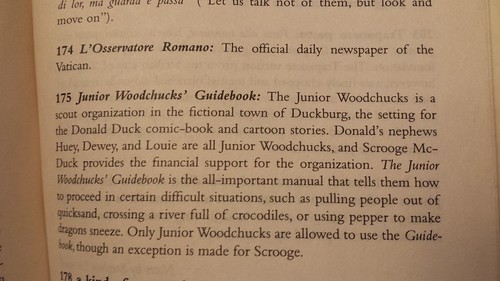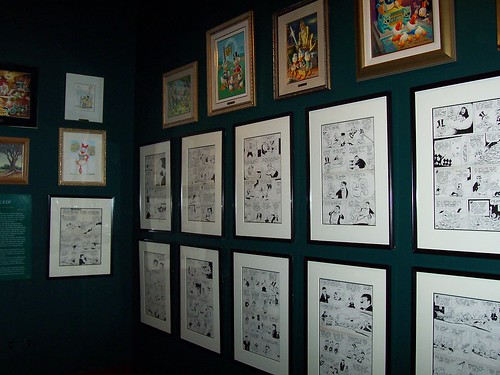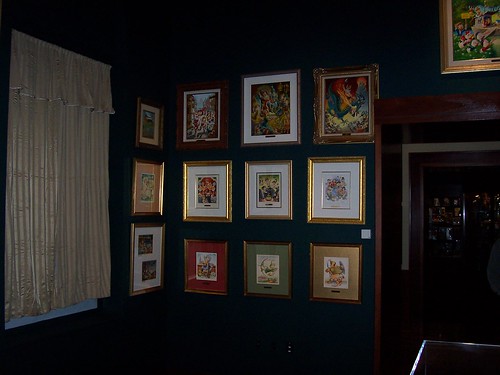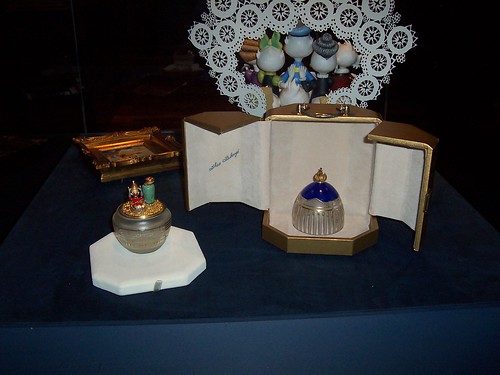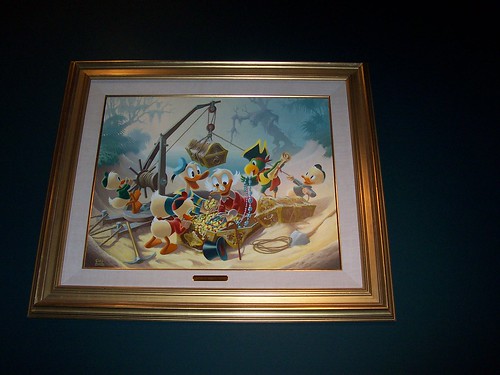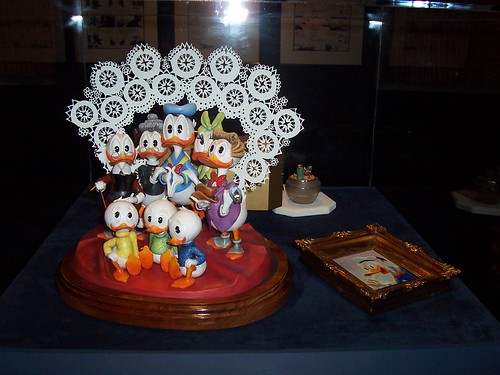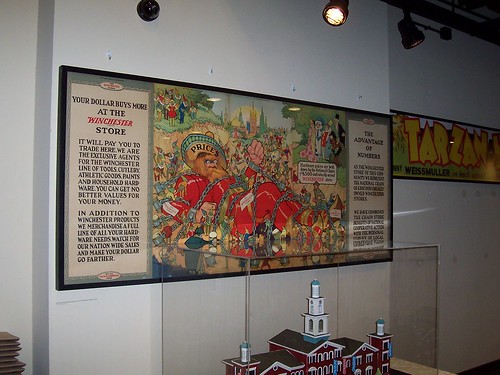Here are reviews for the fall issue of the International Journal of Comic Art that I just turned in tonight. I'm posting them here first because I usually say that I'll be doing a more complete review, but don't get around to it until the last minute. 2 of these shows are gone, but the Herblock exhibit is still up and well worth seeing.
Scrooged! Arnold Blumberg, Andy Herschberger, and John K. Snyder Jr. Baltimore, MD: Geppi’s Entertainment Museum, February 29-May 31, 2008. http://www.geppismuseum.com/ Thanks to the generosity of curator Arnold Blumberg, I saw this exhibit almost a month before it officially opened. All the artwork had been hung, but its final form was different with more labeling and information. Carl Barks was the focus of the exhibit – the title derives from Uncle Scrooge, Barks’ most enduring creation for Disney. The exhibit was rather diffuse, not focusing on any particular aspect of either Scrooge or Barks. It included the complete original artwork for the Scrooge story “North of the Yukon,” oil paintings of the Disney Ducks, oil paintings of landscapes from the 1960s, prints of “Famous Characters In Fictions As Waterfowl,” i.e. Robin Hood as a anthropometric duck, from when Disney was not permitting Barks to paint their ducks, pencil sketches of Disney work, and Another Rainbow objects such as a Faberge egg with Scrooge inside. All the items exhibited are apparently owned by museum founder and Diamond Distributors owner Steve Geppi.
Certainly displaying the entire original “North of the Yukon” artwork is justification enough for a small exhibit on Barks, and I enjoyed this show even though it did not really hold together. See Barks’ small landscapes which were obviously done for his own pleasure, scenes as so many cartoonists do in their retirement, was satisfying. Seeing him draw rather sexy dancing female ducks was odd, but interesting. Blumberg said to me, “I found it most fascinating looking at the paintings. There’s something really luminescent in the way the characters leap off the painting. It’s so much more than a casual viewer expects from a cartoonist.” Blumberg may be selling many cartoonists a bit short, but there is a peculiar fascination in seeing Donald Duck rendered using Old Master techniques, and the exhibit was worth visiting to see examples of Barks’ art beyond the pages of the comic book.
The museum’s current exhibit is “Out of the Box” – a playroom for the type of toys that will eventually make it into the Museum.
Heroes of the Negro League. Mark Chiarello, Michael Barry and Leslie Combemale. Reston, VA: ArtInsights, March 29-May 30, 2008. http://www.artinsights.com/
This exhibit is reviewed by virtue of Chiarello’s position as art editor for DC Comics. In 1990, Chiarello, in collaboration with his best friend Jack Morelli, created baseball cards for forgotten baseball players from the Negro Leagues, who had never had cards in America before. These paintings were watercolors over pencil that were based on photographs. The exhibit came about as the paintings were collected in a book, Heroes of the Negro Leagues (Abrams, 2007; $19.95, ISBN-10: 0810994348). Chiarello and Morelli did research at Cooperstown and the Schomburg Center in Harlem, and Chiarello painted the images from photographs and, surprisingly baseball cards – which had been issued in Cuba and Venezuela for some of the players.
Gallery co-owner Leslie Combemale interviewed Chiarello for a March 10th press release that is no longer on the gallery’s website. An exchange on Chiarello’s techniques is worthy of reprinting here:
LC- The Negro Leagues players portraits have a depth that goes beyond just (an image) How do you find the perfect picture to use?
MM- I can look through 200 or more pictures and only one is just right. With my portraits, I try to let the viewer know who that person is, just by looking in their eyes. I think the Cool Papa Bell is the most successful at that...it's why I chose it for the cover. I know the moment I find the right picture for reference, and I'll keep looking as long as it takes...
LC- Once you find that picture, how do you proceed from there?
MC- I pencil it out as tightly as I can. It’s my roadmap, so there's not much guesswork. After that I just try to get out of the way.
LC- I see your two styles of painting as so different from each other. One being the watercolor you used for the Negro League illustrations and the other the style you paint in oil, used for the Star Wars Celebration "Enlist Now" propaganda limited edition. I think of watercolors as unforgiving, hard to do, and hard to control.
MC- A lot of people say that and I disagree. Maybe it can't be controlled, but that's what's so great about it. After I pencil the image in, painting in watercolor is all about feel, control is beside the point. Your brain has to stay out of it and you have to stay out of the way of the paint. It becomes itself.
LC- What do you mean by that?
MC- For me it becomes about the emotional connection between the artist, the subject, and the wetness of the paint. The watercolor helps you-
LC- If you know what you're doing...
MC- Watercolor is in the moment. It flows into weird shapes and if you corral these shapes, they form the person's face. But you'll never see it if you have expectations or try to control the outcome too much from the beginning. With watercolor, once you have the roadmap a drawing creates, you've done most the work. After that you just have to enjoy the ride...Really my two styles are diametrically opposed. When I paint in oil it's very cerebral, I have to map the entire piece out from start to finish. It’s very precise work. Watercolor is all about flow.
Chiarello was also featured in the April issue of Juxtapose magazine for anyone who would like more details on this project; the paintings were technically excellent and appealing and the exhibit was worth seeing.
The gallery, which sells artwork (including the Negro League paintings) had other items of interest to IJOCA readers. There was an original story book artwork page from Snow White as well as an original movie cel with a background. Other cels from Lady and the Tramp, The Fox and the Hound, Aristocats, Fantasia and Peanuts lined the walls. Combemale told me that for fourteen years the focus of the gallery had been on animation, but recently they were widening their scope. "Tim Rogerson's World of Disney Color," their next exhibit, opens on July 12th.
Herblock’s Presidents: ‘Puncturing Pomposity’. Sidney Hart. Washington, DC: National Portrait Gallery, May 2-November 30, 2008.
Herbert ‘Herblock’ Block died in 2001, but his images linger on in Washington, at least partly because his estate donated over 10,000 of his cartoons to the Library of Congress with the proviso that they be displayed regularly. Curator Sidney Hart, a historian by trade, undertook the current exhibition and did a very credible job. Hart made two key decisions to define the show – it would be on presidents and the cartoon had to be negative. Hoover was not included because he “didn’t fit the theme of our show.” The two decisions had three points backing them up – 1.) Herblock’s presidential cartoons were among his most powerful, 2.) a negative cartoon was a more constructive force and, 3.) the exhibit went into the Presidential Gallery space.
The show was arranged by president beginning with Roosevelt. Herblock’s line was visibly smoother and he used the texture of the paper for shading. On the gallery tour, Hart pointed out some of his favorite cartoons. In one on McArthur and Truman, Truman is on a treadmill that McArthur is pulling in a different direction. For Eisenhower, Herblock drew him in a boat, blowing on a paper sale, while not running the motor on the boat. Another Eisenhower cartoon featured Herblock’s hated foe, Senator McCarthy, who is shown mugging the State Department and the Army, while Eisenhower is told, “Relax – he hasn’t gotten to you yet.” Hart noted the curious omission of no Kennedy cartoon for the Bay of Pigs; the JFK cartoons were usually positive so it was harder to find ones for the exhibit. Herblock’s best cartoon of Lyndon Johnson, from January 6, 1967 read “That’s a little better, but couldn’t you do it in luminous paint.” It showed Johnson looking at a painting of himself and referred to his official White House portrait -- which showed a heroic Johnson, but since LBJ did not like it, it rests in the next gallery over in the Portrait Gallery. Herblock’s Nixon cartoons were among his most famous – the exhibit included ones of Vice President Spiro Agnew in a sewer and the Saturday Night Massacre when Justice Department investigators of the Watergate break-in were fired on Nixon’s orders.
The Ford cartoon that Hart focused on showed both the President and the economy going to hell in a hand basket. Reflecting Block’s fondness for Alice in Wonderland, Jimmy Carter was depicted as the Cheshire Cat. One of the Carter cartoons showed an amazing detail from Block’s working methods – the paste-up corrections were done on mailing labels! Reagan and Nixon got the most cartoons with five each. Reagan was the president that Block disliked the most and his cartoons showed it. Clinton disappointed Herblock and his cartoons frequently showed Clinton with mud from scandals on him.
There was one major flaw in this exhibit for viewers. Some cartoons were matted badly and had their titles covered, or had no titles on them. The June 28, 1990 cartoon of George H.W. Bush crossing a bridge labeled “no new taxes” makes little sense without its caption “Anyhow, it got us across.” Frequently the individual cartoon labels, while full of historical information, were no where near the piece they were describing.
Also on display were Block’s Pulitzer Prize from 1941, a Reuben Award from 1956 and his Presidential Medal of Freedom from 1994 as well as some of his art supplies. A kiosk in the corner had hundreds more cartoons on it. The exhibit had only forty cartoons in it, but they were well selected. The exhibit was of the artwork, not necessarily the content, and seeing the cartoons on a screen detracted from the ideal of the museum in this reviewer’s opinion. As a museum curator myself, I would have stuck the kiosk in the exhibit as well since one always feels that more information is better, but it was not really needed in the show. I believe it became technically possible this year as the Herblock Foundation is planning on issuing a book with an accompanying DVD of 16,000 cartoons for Block’s 100th birthday next year.
Herblock: Drawn from Memory was an accompanying program by Hart who moderated with Pulitzer prize-winning Washington Post reporter Haynes Johnson, Washington Post editorial writer Roger Wilkins and Pulitzer prize-winning cartoonist Tony Auth. The three men mainly talked about Herblock’s mid-career at the Post, especially the Nixon and Johnson years. Block’s internationalist, and thus interventionalist, approach to foreign policy and the display of this in his cartoons was a particularly interesting part of the evening. Auth also made an extremely interesting observation. While Block was a good enough caricaturist to avoid labeling everyone, he still used labels on characters regularly. Auth said, “I was struck going through the exhibit here today – I always thought of cartoons as having kind of a half-life. They being to lose their power – and sometimes it’s a very long half-life and sometimes it’s eternal because it’s beyond the moment – but many cartoons have a relatively short half-life. I realized his use of labels extends that so that coming to a cartoon of his that was done forty years ago, you really can figure out what it’s about whereas a lot of cartoonists expend a lot of energy trying to get away from labels and they end up with cartoons that maybe a week, or two weeks later, you can’t figure out because you don’t know exactly what stimulated this drawing.” For those interested in the program, a recording of it can be found at
http://www.archive.org/details/Herblock-drawnFromMemory Overall Hart did an excellent job boiling down a massive amount of material to a coherent exhibit which, while not large, was well-done and informative.


